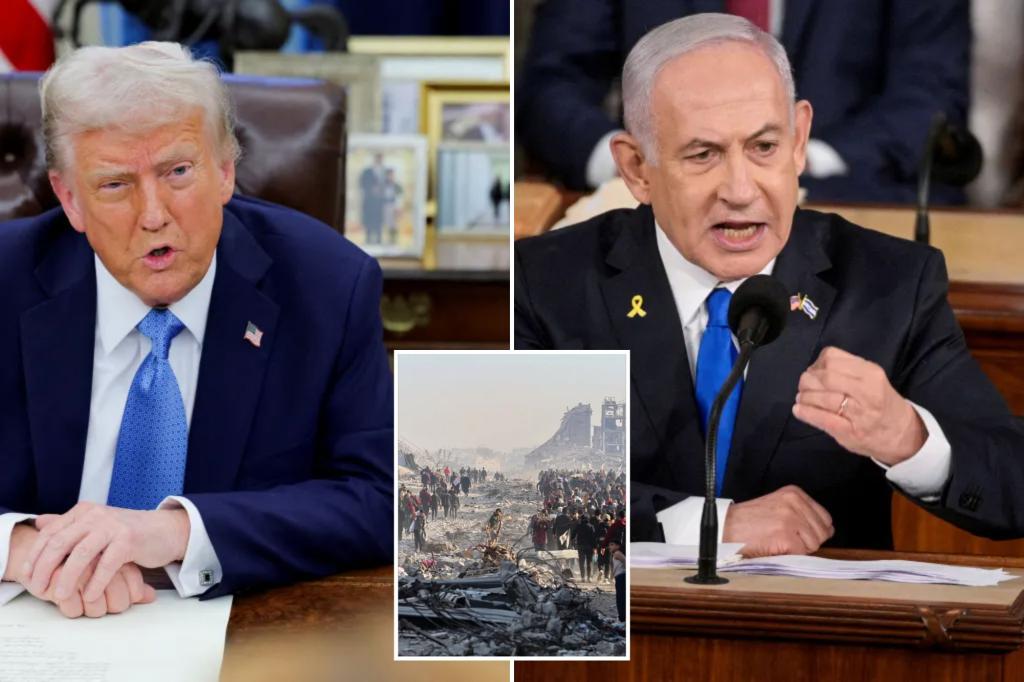WASHINGTON — President Trump believes that the Gaza Strip will remain a wasteland for the next 10 to 15 years and that it’s best for residents to relocate in the meantime, an administration official said Tuesday.
Speaking ahead of Israeli Prime Minister Benjamin Netanyahu’s visit to the White House, the official told reporters on a press call, “President Trump looks at the Gaza Strip and sees it as a demolition site.
“He sees it as impractical for it to be rebuilt within three to five years, believes it will take at least 10 to 15 and thinks it’s inhumane to force people to live in an uninhabitable lot of land with unexploded ordinance and rubble.
“And so he’s looking for solutions for helping the people of Gaza have normal lives while the Gaza Strip is ultimately being rebuilt, and he’s trying to look at this in a realistic way,” the official said.
Trump has already pressured Egypt and Jordan to host Gazans at least temporarily — though Arab leaders rejected the idea because of their concern about long-term demographic changes in the Holy Land, where Palestinians who leave Israel-governed areas historically have been unable to return to their homes.
A second administration official said Trump’s envoy to the region, Steve Witkoff, who played a crucial role in securing a cease-fire between Israel and Hamas last month, agrees that reconstruction could take a far longer period of time than envisioned by the Biden administration.
Witkoff “really thought that the five-year reconstruction element that was put into the deal in May of 2024 was quite unrealistic,” the second official said.
“You’ll need things like a geotechnical survey. There’s no utilities, there’s disease, there’s standing water. You couldn’t get an ambulance through there if you wanted to right now, so that it really is quite uninhabitable.”
The second official said Trump’s plan for temporarily relocating Gazans would “provide dignity for the Palestinian people” and that “what we’ve asked for is to work together with our Arab partners and friends in the region and with Israel, to all come together for creative solutions to this challenge.”
Trump won the Nov. 5 presidential election after courting Jewish and pro-Israel voters as well as Arabs and Muslims fed up with President Joe Biden’s inability to end the Gaza conflict, which started with Hamas terrorists killing about 1,200 people in southern Israel during the Oct. 7, 2023, terror attacks.
The densely populated Gaza Strip has more than 2 million residents — compared to nearly 3 million in the West Bank — and would be an important part of a hypothetical future Palestinian state. Its Hamas-governed residents could not easily emigrate before the war because of tight border controls by Egypt and Israel.
Neighboring war-torn countries have had large-scale emigration themselves, with Syria’s recently ended civil war sending more than 6 million of the country’s roughly 23 million people into exile, following similar mass relocations in Lebanon and Iraq.
It’s unclear if Gazans would be guaranteed a right to return to the Strip under Trump’s plan, and it’s possible many would choose not to do so, potentially tipping the population balance between Jews and Arabs in historically Israeli-controlled areas.
“President Trump’s ideas for the Gaza Strip — to ‘clean out the whole thing’ — is supported by the far right in Israel and by several members of the Likud party,” Alex Mintz, a national security expert and senior professor at Israel’s Reichman University, told The Post.
“Cabinet Ministers [Bezalel] Smotrich and [Iramar] Ben-Gvir’s agenda and dream is to transfer Palestinians from the area to other countries. Smotrich even revealed that he is working on an ‘operational plan’ in support of this idea.”
Ben-Gvir nearly torpedoed Israel’s cease-fire deal with Hamas, saying it failed to eliminate the terror group and ensure an opportunity for Israel to reconstitute and run Gaza, from which Israeli forces and settlers previously withdrew in 2005 under then-Prime Minister Ariel Sharon.
Trump said Monday that Israel’s small geographical size was “not good” — after musing on the campaign trail about how the Jewish state might need to be enlarged and blessing the Israeli annexation of the Golan Heights from Syria during his first term.
“I actually said is there any way of getting more? It’s so tiny,” he said last year.
Read the full article here

